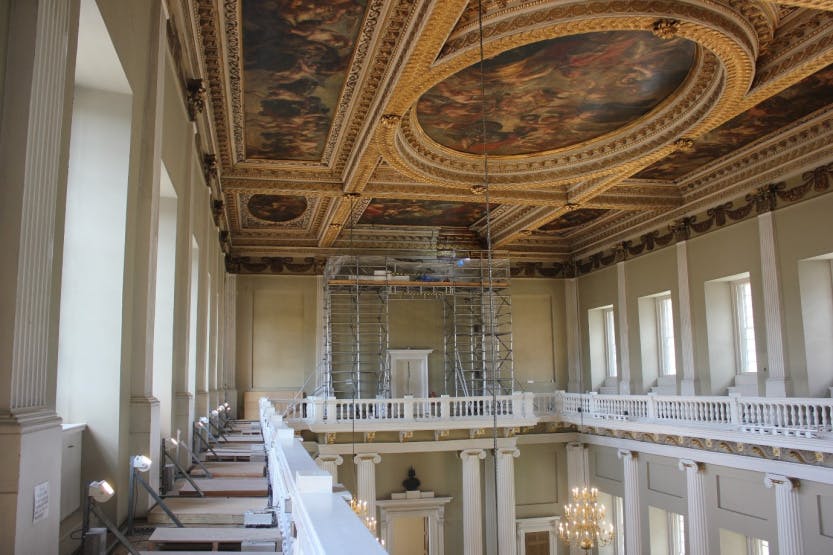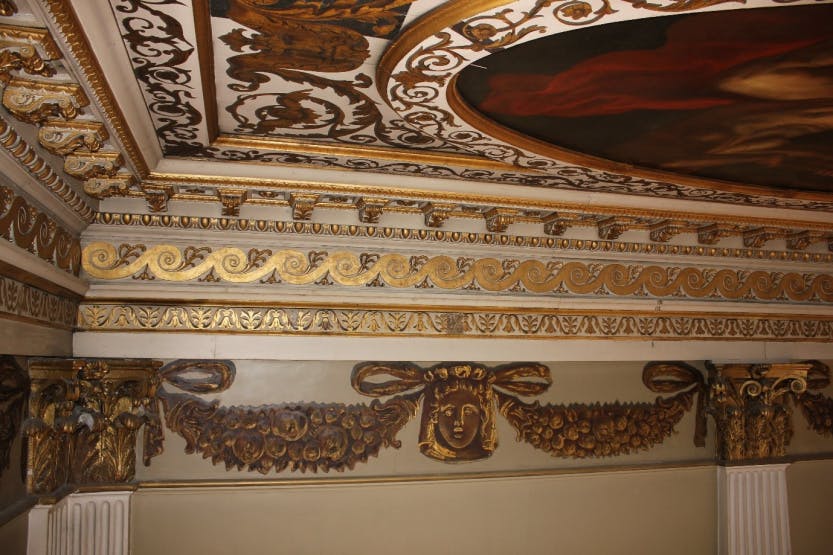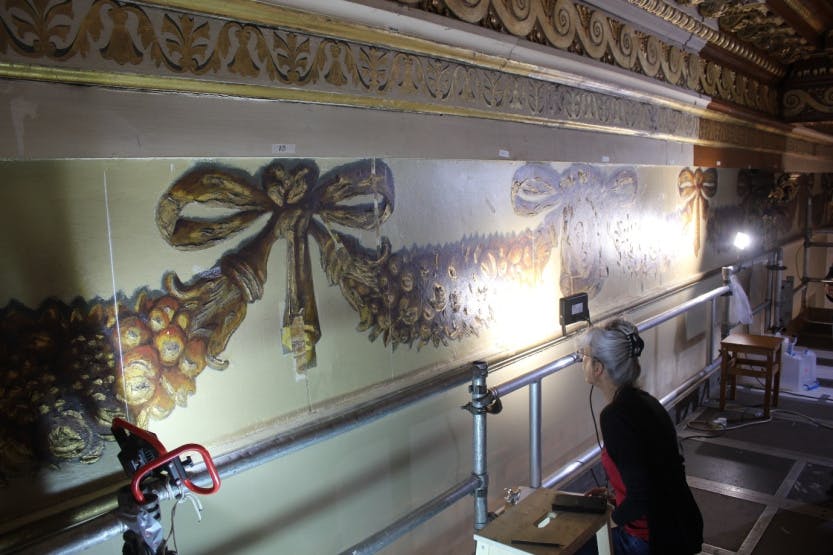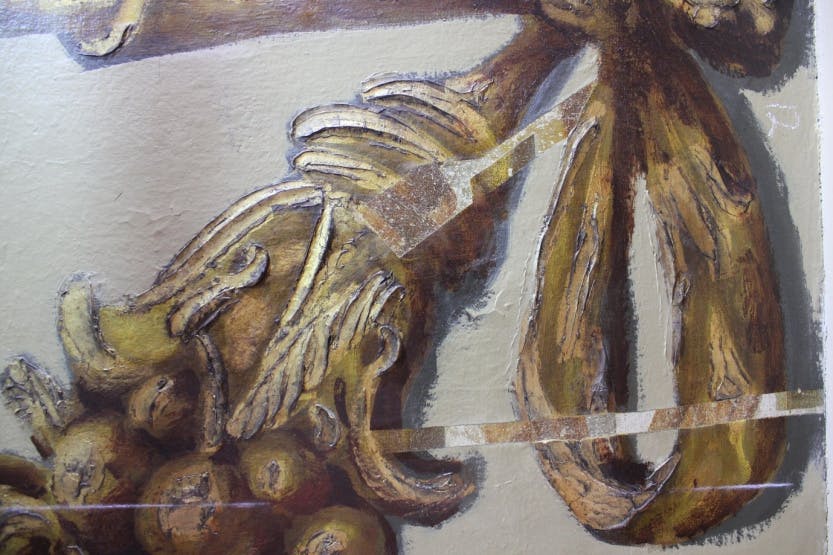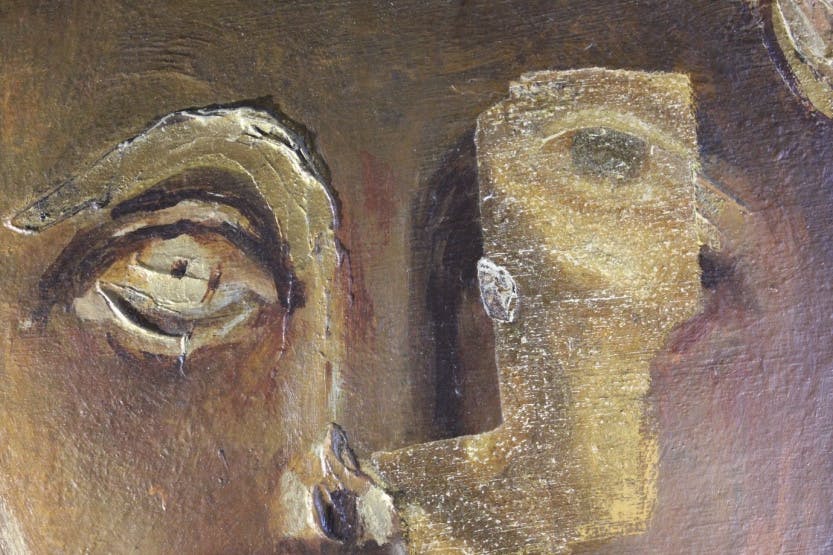Festooned with Mystery: Wall Paintings at the Banqueting House
Date: 07 November 2019
Author:
Jane Spooner
An investigation into some mysterious mural paintings in the Banqueting House took place with a scaffold built for conservators to inspect the often overlooked wall paintings just beneath the magnificent ceiling.
Painted by superstar artist Peter Paul Rubens, the ceiling paintings on canvas usually attract all the attention, but the less showy murals painted at the top of the walls are important too, as they form part of the Banqueting House's early decorative scheme.
The building was created by architect and designer Inigo Jones for King James I between 1619-22, with Rubens' paintings added in 1636 after a commission by James' son Charles I. The whole building was a spectacular addition to Whitehall Palace, most of which burnt down in 1698 and is now lost to history.
The murals are just beneath the ceiling, in between ornately carved and gilt capitals. They are of classical-style dramatic masks connected by ribbons tied into bows, and flanked by festoons (garlands) of fruit and foliage. The design matches carved decoration at the same level on the outside of the building and reflects the original function of the Banqueting House as a venue for elaborate theatrical performances known as masques. The murals are painted in brown-toned grisaille (monochrome), with details picked out in gold and yellow.
Why are these paintings so mysterious?
Perhaps surprisingly, the wall paintings have never been seriously studied. Their significance has always been dwarfed by that of Rubens' paintings, and their appearance has been damaged by unsympathetic restorations. But as the building's curator and conservator, we were keen to find out more about the early paint schemes.
In the mid-1660s architect Christopher Wren made a drawing of the original wall paintings. Later, in 1728-32, artist William Kent was tasked with restoring these 'masks, festoons and other ornaments painted all around the room in yellow and heightened with gold' at the same time as restoring the Rubens paintings. Architects John Soane and Robert Smirke then carried out a major restoration of the whole building in the 1830s, and the murals were completely repainted at this point. Fast forward to the mid-20th century, and the masks and festoons were 'touched up' yet again, and painted over and around with thickly applied paint.
This August, Historic Royal Palaces' conservators contracted wall paintings specialists to uncover small 'windows' into the murals, as well as survey their general condition. They investigated by very carefully removing small areas of individual paint layers using scalpels, a steady hand, magnifying lenses, and an awful lot of patience! The team attempted to locate the original 17th-century scheme, and also to distinguish between the finely painted Victorian scheme underneath the more recent additions. This investigation followed paint analysis carried out last year, where minute cross-sections of paint were taken from the wall and examined under a microscope. This analysis had confirmed the presence of early paint layers.
After all that effort, what did we find?
It soon became clear that the very early original masks and festoons were still surviving beneath all the later repaints! A 'eureka' moment came when we found a serene, unblinking eye staring out at us from a mask probably painted under the direction of Inigo Jones himself in around 1636-7, when the Banqueting Hall was redecorated. More uncovering revealed that the original scheme was quite intact, and was positioned slightly differently than the later restorations. It was beautifully painted in yellow and brown glazes, with details picked out in gold leaf, on a cool grey background. On top of this paint layer was the Victorian scheme - fluently painted, but spoiled by the clumsily applied highlights and shadows added in the 20th century.
The next stage is to record everything we have found into an illustrated report for our archives, and to use the results of the investigation to guide us in understanding and caring for the wall paintings in the future.
This was a wonderful project to work on - it's not every day that you get to solve a mystery about a lost painting in a lost palace!
Jane Spooner (Curator)
Amy Anderson (Conservator)
More from our blog

Secrets of Henry VIII's Whitehall: The Archaeology of a Lost Palace
17 August 2023
More than 300 years after the destruction of Whitehall Palace by fire, archaeological excavation and scientific analysis continue to uncover the lost stories and secrets of Henry VIII's once elaborate home.

The Tempest at Whitehall Palace
01 November 2021
1 November 1611 was the first recorded performance of William Shakespeare's The Tempest. Curator Brett Dolman reflects on the Jacobean court setting in which it was first performed and how its themes reflect the ambitions and fears of James I's reign.

Conservation and discoveries in our paper collections
06 February 2020
We have around 25,000 works of art on paper in Historic Royal Palaces' collection. While many are on display, the vast majority are held in storage. These are delicate items and it's essential to conserve and store them correctly in order to preserve them for posterity.

